WAR GRAVE
WILLIAM W. STAINTHORPE AFC (grave 26)
WING COMMANDER
83 SQUADRON
ABOUT MY LIFE
Born: 25th December 1910
Died: 27th February 1941
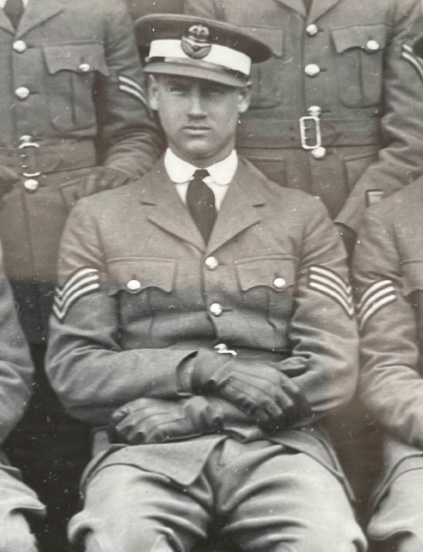
I was born in Guisborough North Yorkshire on Christmas Day 1910. My father was the local doctor and Justice of the Peace and we lived in Sunnyfield House together with my mother Eugenie, a brother and two sisters. My father was well known in the local community and a window was dedicated to him in the local church, just before his death in the 1950’s.
I was educated at the Old College in Windermere and later Dover College in Kent. The Old College in Windermere was a school of some repute and boasts alumni including the actors Gregory Peck and James Mason as well as the Swallows and Amazons author Arthur Ransome.
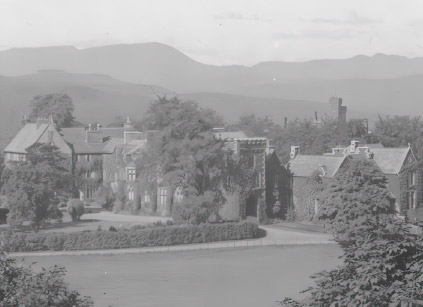
The Old College Windemere.
I learnt to fly at the Newcastle Aeroclub in 1929 and was awarded Pilot’s Licence number 8490 by the Royal Aeronautical Club. The relatively low number high-lighting just how much aviation was in its infancy.
On the 5th September 1929, I entered the prestigious Royal Air Force College at Cranwell as a Flight Cadet, graduating as a Flight Cadet Sergeant on 24th July 1931 as a fully qualified pilot.
On the 28th October 1935, I had a lucky escape whilst I was flying a Hawker Hart K3155 over Mexborough in South Yorkshire. The engine of the aircraft failed and I had to make a forced landing in a field near Denaby Main. Despite running through a hedge, crossing a second field, before coming to rest at the edge of a wood, I escaped without injury. The aircraft was not so lucky, and was damaged beyond economical repair. On the 1st January 1941 I was awarded the Air Force Cross for my work at the Central Flying School at RAF Upavon.
On 16th February 1941, I was appointed as the Officer Commanding 83 Squadron at Scampton, Just 11 days later, I was to lose my life.
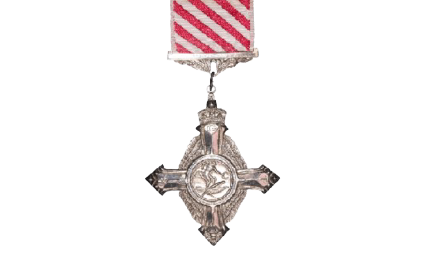
MY AIRCRAFT
The Hampden was a medium bomber with a crew of 4. Pilot, Navigator, Wireless Operator/gunner and a further gunner. Although it was a vast improvement on the biplanes 83 Squadron had been flying just before the war opened, in reality it was already obsolete. Early daylight raids had been a disaster, the bomber was too slow to evade German fighters and its guns were no match for the Germans either. The distinctive fuselage, designed to give the aircraft a sleek, aerodynamic profile, led to the Hampden earning its nickname of “The Flying suitcase”.
Crew: 4
Span: 21.09 m
Length: 16.32 m
Height: 4.37 m
Wing area: 63.90 m²
Empty weight: 5,344 kg
Loaded weight: 8,508 kg
Engine: 2 x Bristol Pegasus XVIII 9-cylinder radial engines
Engine power: 980hp each
Maximum speed: 410 km/h
Rate of climb: 5.00 m/s
Range normal: 1,095 km
4 or 6 x 7.7mm Vickers K machine guns (1 flexible, 1 nose, 1 or 2 dorsal, 1 or 2 ventral)
1,814kg of bombs/mines or 1 x 18in torpedo
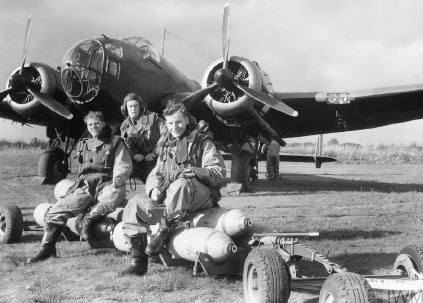
An 83 Squadron crew in front of their Hampden.
MY ROLE
On this mission, I was the pilot. The Hampden had just one seat for a pilot and I would remain in this position throughout the mission.
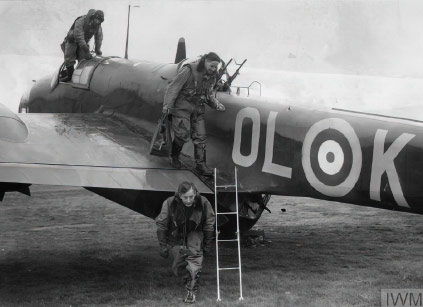
MY SQUADRON
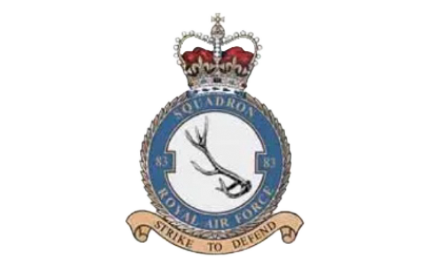
Motto: Strike to Defend
83 Squadron was formed at Montrose on 7th January 1917 as a night bomber squadron. Moving to France in March 1918, the squadron saw action on the western Front and took part in operations to counter the German’s Spring Offensive. Following the end of the war, the Squadron was disbanded on 31 December 1919.
With the threat of war once again looming over Europe, 83 squadron was reformed at RAF Turnhouse on 4th August 1936, flying the Hawker Hind biplane. In March 1938, the squadron re-equipped with Handley Page Hampdens at RAF Scampton.
In the summer of 1940, the Squadron received one of Scampton’s three Victoria Crosses due to the heroic actions of Flight Sergeant John Hannah in putting out the fire on a battle damaged Hampden.
In December 1941, the squadron re-equipped with the infamous Avro Manchester, but the poor reliability of this aircraft led to them quickly being re-equipped with the legendary Avro Lancaster, with which the squadron fought the rest of the war. In August 1942, the squadron became a pathfinder unit, leading large bomber formations to their targets and laying target indicator flares so they could be more accurately hit.
After the war, they flew Avro Lincolns and Avro Vulcans, before being disbanded in 1969.
THE ACCIDENT
This was my first operational mission as the Officer Commanding 83 Squadron and I was to lead 9 of my Squadron’s aircraft on a mission to bomb Cologne in Germany. We took off at 9:50 pm on 26th February 1941 and at first the mission went well, Flak was ineffective and the target was located in an area of clear weather. Despite these ideal conditions, it was later found that the bombing caused very little damage, with only 10 high explosive bombs and 9 incendiaries falling on the entire city. To put this into context, only 1 or 2 aircraft from the entire force of 126 managed to hit the city.
On the way home, the weather deteriorated and by the time our aircraft returned, there was a thick over-cast with snow and rain below it. I was now lost and low on fuel, but the RAF had anticipated situations like this and had set-up a system called Darky. By transmitting on a special frequency, a pilot could ask for a position fix. There were receiver units all over the country, which could tell from which direction the transmission came. If several units received the same transmission, they could compare each other’s bearings and triangulate the position of the aircraft. This position would then be transmitted to the aircraft, and it could then navigate to safety.
At 01:20am on the 27th, the Darky station at Neston near Birmingham achieved a fix, putting my aircraft 15 miles south-east of Birmingham. However, we lost radio contact before the life-saving fix could be passed to us and we crashed into high ground at Derrington Cross near Stafford. Investigators later found out that this was only my second flight at night in my entire flying career.
CASUALTIES – 27TH FEBRUARY 1941
Wing Commander William Stainthorpe AFC (Pilot) (Buried Scampton)
Pilot Officer Alexander Melville (Navigator) (Buried Chesham Burial Ground)
Sergeant Leslie Emmerson (WOp/Air Gunner) (Aklam Cemetery, Middleborough)
Sergeant Douglas Vincent Weaving (Air Gunner) (Buried East Finchley Cemetery
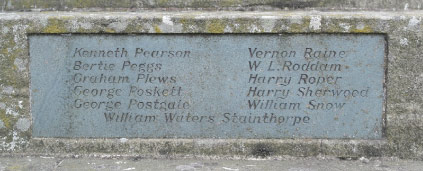
Guisborough War Memorial.

Where Next
Visit my home at Guisborough, Sunnyfield House, 36 Westgate, Guisborough. TS14 6BA
ON THIS DAY IN WORLD WAR TWO – 27TH FEBRUARY 1941
Martial law declared in Amsterdam as 389 Jews are arrested and deported to Buchenwald Concentration Camp.
Australian Prime Minister Robert Menzies agrees to send troops to Greece.
The New Zealand cruiser Leander sinks the Italian merchant raider Ramb I.
